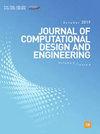Topology optimization for additive manufacturing with strength constraints considering anisotropy
IF 6.1
2区 工程技术
Q1 COMPUTER SCIENCE, INTERDISCIPLINARY APPLICATIONS
引用次数: 2
Abstract
Combining topology optimization and additive manufacturing (AM) is a promising approach to breaking through the limitations of conventional design and developing innovative structures with high performance. However, the unique manufacturing constraints in AM should be considered when developing the topology optimization algorithms for AM. Material anisotropy is one of the common characteristics of AM materials due to the layer-by-layer manufacturing techniques. The present work proposes a topology optimization approach for AM with strength constraints considering anisotropy. The Hoffman failure criterion is adopted to represent the anisotropic strength behaviors of AM materials. Based on the Hoffman failure criteria and the p-norm measure aggregation function, a global strength constraint formulation is established. Under the framework of solid isotropic material with penalization (SIMP), we develop a topology optimization methodology to minimize the structural weight or volume fraction subject to structural stiffness and strength constraints. Several 2D or 3D numerical test cases are performed to validate the effectiveness and performance of the developed method. The results indicated that the proposed method could make full use of material properties by considering anisotropic strength. Besides, the topological optimization considering strength anisotropy could be combined with build direction optimization to further reduce the structural weight.考虑各向异性强度约束的增材制造拓扑优化
将拓扑优化与增材制造(AM)相结合是突破传统设计限制、开发高性能创新结构的一种很有前途的方法。然而,在开发增材制造拓扑优化算法时,必须考虑增材制造中独特的制造约束。由于采用逐层制造技术,材料的各向异性是增材制造材料的共同特征之一。本文提出了一种考虑各向异性的强度约束的增材制造拓扑优化方法。采用Hoffman失效准则表征增材制造材料的各向异性强度行为。基于Hoffman失效准则和p范数测度集合函数,建立了整体强度约束公式。在具有惩罚的固体各向同性材料(SIMP)框架下,我们开发了一种拓扑优化方法,以在结构刚度和强度约束下最小化结构重量或体积分数。通过若干二维或三维数值试验验证了所开发方法的有效性和性能。结果表明,该方法可以充分利用材料的各向异性强度。此外,考虑强度各向异性的拓扑优化可以与构建方向优化相结合,进一步减轻结构重量。
本文章由计算机程序翻译,如有差异,请以英文原文为准。
求助全文
约1分钟内获得全文
求助全文
来源期刊

Journal of Computational Design and Engineering
Computer Science-Human-Computer Interaction
CiteScore
7.70
自引率
20.40%
发文量
125
期刊介绍:
Journal of Computational Design and Engineering is an international journal that aims to provide academia and industry with a venue for rapid publication of research papers reporting innovative computational methods and applications to achieve a major breakthrough, practical improvements, and bold new research directions within a wide range of design and engineering:
• Theory and its progress in computational advancement for design and engineering
• Development of computational framework to support large scale design and engineering
• Interaction issues among human, designed artifacts, and systems
• Knowledge-intensive technologies for intelligent and sustainable systems
• Emerging technology and convergence of technology fields presented with convincing design examples
• Educational issues for academia, practitioners, and future generation
• Proposal on new research directions as well as survey and retrospectives on mature field.
 求助内容:
求助内容: 应助结果提醒方式:
应助结果提醒方式:


